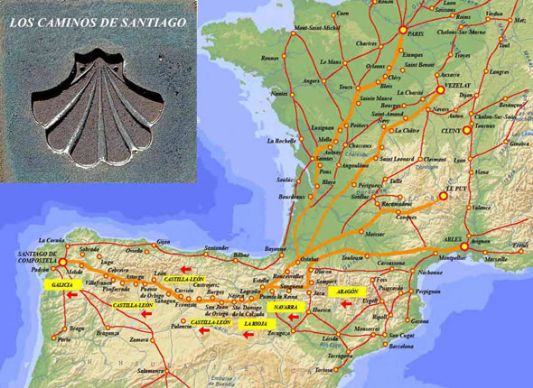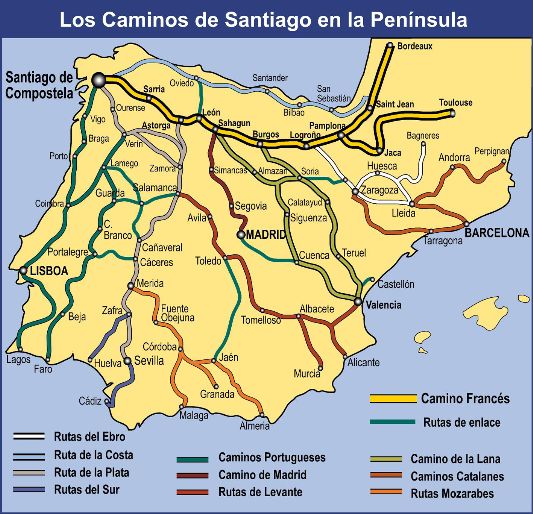“Camino de Santiago” or Santiago’s Way is a labyrinth of routes flowing across all of Europe and culminating in the town of Santiago de Compostela.


Not so well known in the UK but pilgrims have been trekking these routes for hundreds of years. Although it was originally and still is a religious pilgrimage, more recently even devote Atheists have booted up and hiked all the way to Santiago’s resting place. This pilgrimage has become a very popular challenge for ones that love outdoor activities. I have asked many people who have done the “Camino” to explain to me the importance and the reason why they do it and more importantly how it originated, but very few have every really been able to explain what it is all about. Clearly the majority of my friends are atheists or non-practicing Catholics, as they really didn’t have a clue, they just went along for the ride so to speak. Like so many traditions, the real reason behind them gets lost in time. Ask any Valenciano how “Fallas” originated and the vast majority won’t even know where to start. They’ve just always celebrated it!
“El Camino de Santiago” is nowadays more a pilgrimage of self-discovery with more of a spiritual focus rather than a religious one. Paulo Coelho’s book “The Pilgrimage” helped boost popularity of this tradition reaching out to people from all walks of life. Everyone, looking to spend time with their thoughts and pursuing their inner-self as they walk the extremely long routes to the final destination. I must admit that it seems a very attractive proposition especially with the stress and pressure of modern day life. Just walking and walking and walking for days on end would certainly give you time to disconnect and focus on who you are, what you are doing and where you want to go with your life. It has been a life changing experience for many. As the routes are established you will always meet people along the way, young and old from many different countries, however those who strictly do it according to tradition will do it in silence and not talk along the way. But from what I have heard there aren’t many of those.
But who is Santiago?
Santiago de Compostela, everyone’s final destination is in the northwest of Spain, in the green Celtic Galicia. The Roman’s referred to it as “Finis Terrae” as it was the westernmost point of the known world. Tradition has it that the Apostle James, Jacob in Spanish and later Santiago was the eldest son oF Zebedee and brother to John the Evangelist. It is believed that he was awarded the Spanish lands in order to preach the Gospel. As he carried out his task he came to find the mouth of the river Ulla. But having had little success in finding followers and just a small number of disciples, he decided to return to Jerusalem. When he returned to Palestine in the year 44, he was tortured and beheaded by Herod Agrippa and his was refused a burial. However his disciples secretly stole his body from the grasp of Herod and took it to shore where they found a boat ready to sail but without a crew. They placed the body in a marble arc and sailed away. After the sea crossing they eventually sailed up the river Ulla to the Roman Port of Iria Flavia , the Roman capital of Galicia. They then moved the arc to a nearby forest called Liberum Donum and buried the body there building an altar around the marble arc.
Its existence was forgotten due to persecutions and prohibitions until 813 when the hermit Pelayo observed flashes followed by sparkles of light and heard chants coming from area where the tomb was. Due to this occurrence the area was named Campus Stellae – Star Field, from which the current name “Compostela” is derived,hence the name of the City Santiago de Compostela.
.jpeg) The hermit informed the Bishop of Iria Flavia, Teodomiro, who after removing the weeds and grass from the area discovered the tomb of the Apostle with his inscription on the headstone. King Alfonso II was informed of the discovery and he rushed to the scene and proclaimed Saint James the patron saint of the Kingdom. He built a sanctuary that would leter become Santiago de Compostela’s Cathedral. Over time numerous miracles and apparitions were recorded giving birth to a movement of pilgrims who began to trace the routes of the Camino de Santiago over the centuries. In the XII and XIII century the City of Santiago de Compostela was at its peak when the “Codex Calxtino”: The first Pilgrims Guide, was written. Pope Callistus II and Alexander II declared Santiago de Compostela the third Holy City after Jerusalem and Rome.
The hermit informed the Bishop of Iria Flavia, Teodomiro, who after removing the weeds and grass from the area discovered the tomb of the Apostle with his inscription on the headstone. King Alfonso II was informed of the discovery and he rushed to the scene and proclaimed Saint James the patron saint of the Kingdom. He built a sanctuary that would leter become Santiago de Compostela’s Cathedral. Over time numerous miracles and apparitions were recorded giving birth to a movement of pilgrims who began to trace the routes of the Camino de Santiago over the centuries. In the XII and XIII century the City of Santiago de Compostela was at its peak when the “Codex Calxtino”: The first Pilgrims Guide, was written. Pope Callistus II and Alexander II declared Santiago de Compostela the third Holy City after Jerusalem and Rome.
.jpeg)
Many dream of walking the entire length of the “Camino Frances” – The French Path that spans 775km. Others dream of walking the “El Camino de la Plata” which starts in Seville and spans 705km but few actually do it! In total there are 10 established routes ranging from 119km to 775km. All of the routes are broken down into “stages” of approximately 20 to 30km each. So most people opt for a just a few stages and pick up the route “further down the road” so to speak, so it really depends how much time you can get away from the constraints of life and avoid making any commitments! No mobile phone (unless it’s an emergency), you can plan your stops along the way or just go on an adventure and stop off at hostels, or even a hotel, which may be better for those who still can't give up all their creature comforts. My friend came across a German women about 30 km from Compostela, who had been walking for over three months, carried no phone, virtually no money and had not contacted anyone back home in all that time. Some people take it very seriously. However the majority see it as an opportunity to well and truly disconnect.
.jpeg)
The distance will depend on how fit you are and how much time you can really take off from the real world. Just imagining it brings me a huge amount of peace and tranquillity. The thought of just walking and walking and walking without any other commitment than to keep going forward. Stress free, for a moment all problems are placed on hold and it is as if life has frozen while you embark on your adventure. I think it is so attractive because it goes against all the negative aspects of daily basis and I imagine it as a totally liberating experience. I have been toying with the idea for some time, but when I finally decide to do it I want to take at least a month off so I am not in any rush to get back to the real world and I am sure it will be a fulfilling experience. At present I have no fixed date but everyday that passes I feel I need to do it even more.

Here is a link that shows all the routes leading to Santiago de Compostela and the different stages where there are hotels and hostels.
Camino de Santiago Routes